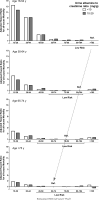Structural and Functional Changes With the Aging Kidney
- PMID: 26709059
- PMCID: PMC4693148
- DOI: 10.1053/j.ackd.2015.08.004
Structural and Functional Changes With the Aging Kidney
Abstract
Senescence or normal physiologic aging portrays the expected age-related changes in the kidney as compared to a disease that occurs in some but not all individuals. The microanatomical structural changes of the kidney with older age include a decreased number of functional glomeruli from an increased prevalence of nephrosclerosis (arteriosclerosis, glomerulosclerosis, and tubular atrophy with interstitial fibrosis), and to some extent, compensatory hypertrophy of remaining nephrons. Among the macroanatomical structural changes, older age associates with smaller cortical volume, larger medullary volume until middle age, and larger and more numerous kidney cysts. Among carefully screened healthy kidney donors, glomerular filtration rate (GFR) declines at a rate of 6.3 mL/min/1.73 m(2) per decade. There is reason to be concerned that the elderly are being misdiagnosed with CKD. Besides this expected kidney function decline, the lowest risk of mortality is at a GFR of ≥75 mL/min/1.73 m(2) for age <55 years but at a lower GFR of 45 to 104 mL/min/1.73 m(2) for age ≥65 years. Changes with normal aging are still of clinical significance. The elderly have less kidney functional reserve when they do actually develop CKD, and they are at higher risk for acute kidney injury.
Keywords: Aging; Glomerular filtration rate; Glomerulosclerosis; Kidney function; Nephrosclerosis.
Copyright © 2016 National Kidney Foundation, Inc. Published by Elsevier Inc. All rights reserved.
Figures





References
-
- Rodriguez-Castro EM, Cordova HR. Aging and the kidney. Bol Asoc Med P R. 2011 Jul-Sep;103(3):57–62. - PubMed
-
- Hemmelgarn BR, Zhang J, Manns BJ, et al. Nephrology visits and health care resource use before and after reporting estimated glomerular filtration rate. Jama. 2010 Mar 24;303(12):1151–1158. - PubMed
-
- Schaeffner ES, Ebert N, Delanaye P, et al. Two novel equations to estimate kidney function in persons aged 70 years or older. Ann Intern Med. 2012 Oct 2;157(7):471–481. - PubMed
-
- Al-Said J, Brumback MA, Moghazi S, Baumgarten DA, O'Neill WC. Reduced renal function in patients with simple renal cysts. Kidney Int. 2004 Jun;65(6):2303–2308. - PubMed
Publication types
MeSH terms
Grants and funding
LinkOut - more resources
Full Text Sources
Other Literature Sources
Medical

